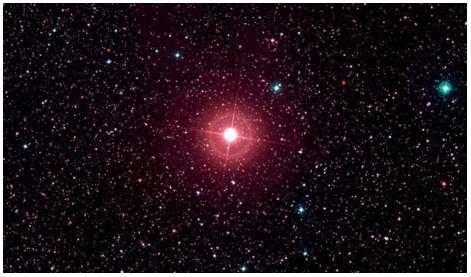VV Cephei is a mass-exchanging eclipsing binary star which consists of VV Cephei A, a red supergiant, and VV Cephei B, a blue main sequence star. It can be found in the middle of the constellation Cephus, which gives it its name. Its exact distance from the Earth is unknown because the size, mass and luminosity of the stars in this system are not certain, but it is believed to be between 1,500 and 5,000 light years away from the Earth.

The system
The two stars orbit each other at an average distance of 25 astronomical units, although this can range from 17 to 34 astronomical units. This is roughly the distance from the Sun to Uranus at the closest and Neptune at the furthest. The estimated period is 20.4 years, although it has sometimes changed suddenly.
Exact knowledge of this system, including its distance from Earth, is hampered by several factors. The dwarf star is by far the smaller of the 2 stars in this system, so it is eclipsed for nearly 2/3 of the year. During these times, the light from binary star is roughly 20% less than when both stars are fully visible. During most of the time when both stars are visible, so much mass flows between them that the stars cannot be distinguished spectrally with certainty. To complicate viewing even further, VV Cephei is located behind dust clouds.
The distance of the system from the Earth is usually estimated based on the known distance of other stars in the Cephus OB2 association of stars, of which VV Cephei may be a member. However, some astronomers believe that VV Cephei has no connection with this group of stars.
In that case, other tools must be used to determine distance. The results from those tools have varied widely, so that VV Cephei may be as close to Earth as 1,500 AU or as far away as 5,000 AU.
VV Cephei A
VV Cephei A is a class M2 red supergiant which may be as large as 92% the size of Saturn’s orbit. Even the low-end estimates are larger than the orbit of Jupiter. These estimates make it the second largest known star in the Milky Way, and the third largest which has been discovered to date.
Both spectral analysis and temperature analysis are confused by the tidal distortion caused by its companion star. These circumstances mean that neither the radius nor the temperature is constant. Estimates of size and luminosity are also based on the estimated distance of a star from the Earth, which is not known for sure. It is also thought to be a pulsating semi-regular variable.
Measurements which are estimated by different methods also seem to contradict each other. For example, the low-end size estimates based on temperature, which put VV Cephei A solidly within known ranges, do not match well with size estimates which are based on either spectral or eclipse analysis.
Based on current astronomical knowledge, VV Cephei A is probably a star near the end of its life. Although spectral analysis is uncertain, VV Cephei is thought to be fusing helium into carbon in its deep core. If this is accurate, it is likely to explode into a supernova fairly soon, in astronomical terms.
VV Cephei B
VV Cephei B is a class B blue-white dwarf star which is unusually hot and dense and is in the hydrogen-fusing stage of its life. It is much smaller but much denser than its companion star, which pulls VV Cephei A into a teardrop shape. The distortion tidally follows VV Cephei B throughout the orbit.
Because of the prolonged eclipse period, even less is known about VV Cephei B than about VV Cephei A. It is probably no more than 10 times larger than the Sun. However, it is thought to be 100,000 times as bright as the Sun.
VV Cephei B is close enough to VV Cephei A that a supernova from the latter will engulf the former. Even astronomers are not sure what the results of that kind of interaction might be.

